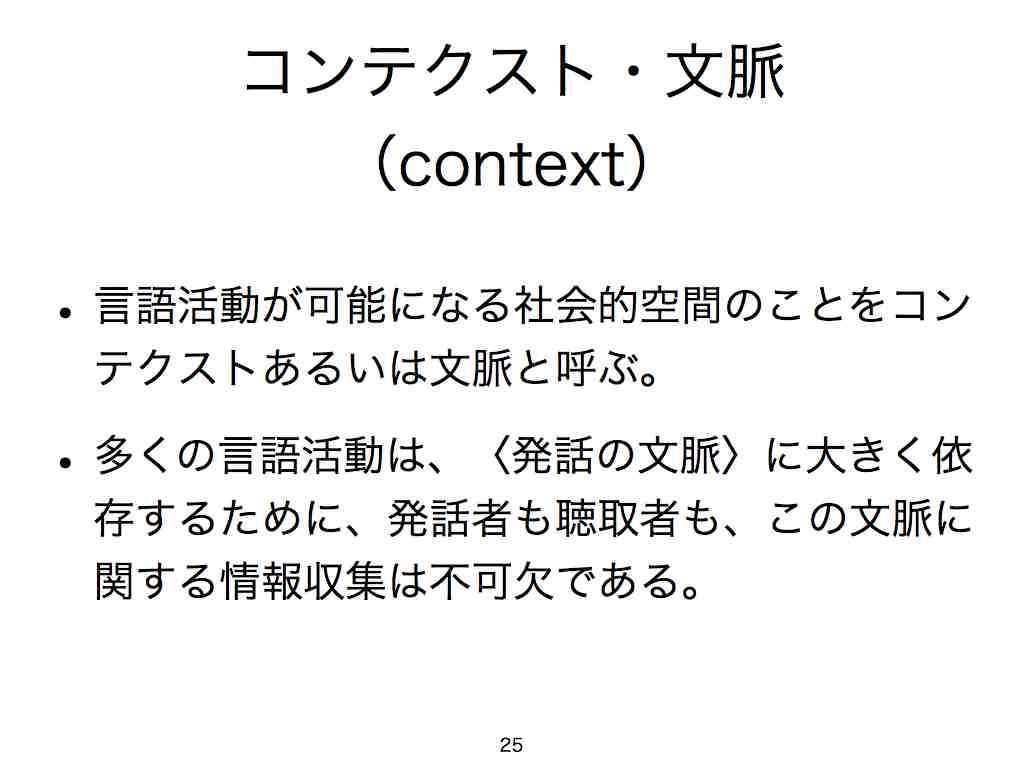

コンテクスト・文脈
context
Charles
Sanders Peirce, 1839-1914 and the concept of hyper-text
☆言語活動が可能になる社会的空間のことをコンテクストあるいは文脈(脈絡) と呼ぶ。多くの言語活動は、〈発話の文脈〉に大きく依存するために、発話者も聴取者も、この文脈に関する情報収集は不可欠である。また、コンテキストをある単語が埋め込まれた塊(ブロック)と解釈すると、ある単語をインデックスとするハイパーテキスト化とは、その単語の「意味」に直接ワープするデータベースであると定義することができる。
| ★In
semiotics, linguistics, sociology and anthropology, context refers to
those objects or entities which surround a focal event, in these
disciplines typically a communicative event, of some kind. Context is
"a frame that surrounds the event and provides resources for its
appropriate interpretation".[1]: 2–3 It is thus a relative concept,
only definable with respect to some focal event within a frame, not
independently of that frame. |
記号論、言語学、社会学、人類学において、文脈とは、焦点となる出来事
(これらの分野では通常、何らかのコミュニケーション上の出来事)を取り囲む対象や実体を指す。文脈とは「出来事を取り囲み、その適切な解釈のためのリ
ソースを提供するフレーム」である[1]。 |
| In linguistics In the 19th century, it was debated whether the most fundamental principle in language was contextuality or compositionality, and compositionality was usually preferred.[2] Verbal context refers to the text or speech surrounding an expression (word, sentence, or speech act). Verbal context influences the way an expression is understood; hence the norm of not citing people out of context. Since much contemporary linguistics takes texts, discourses, or conversations as the object of analysis, the modern study of verbal context takes place in terms of the analysis of discourse structures and their mutual relationships, for instance the coherence relation between sentences. Neurolinguistic analysis of context has shown that the interaction between interlocutors defined as parsers creates a reaction in the brain that reflects predictive and interpretative reactions. It can be said then that mutual knowledge, co-text, genre, speakers, hearers create a neurolinguistic composition of context.[3] Traditionally, in sociolinguistics, social contexts were defined in terms of objective social variables, such as those of class, gender, age or race. More recently, social contexts tend to be defined in terms of the social identity being construed and displayed in text and talk by language users. The influence of context parameters on language use or discourse is usually studied in terms of language variation, style or register (see Stylistics). The basic assumption here is that language users adapt the properties of their language use (such as intonation, lexical choice, syntax, and other aspects of formulation) to the current communicative situation. In this sense, language use or discourse may be called more or less 'appropriate' in a given context. |
言語学において 19世紀、言語における最も基本的な原理は文脈性か構成性かについて議論され、通常は構成性が優先された。言葉による文脈は、ある表現がどのように理解さ れるかに影響を与えるため、文脈から外れた引用をしないという規範がある。現代の言語学の多くは、テキスト、言説、会話を分析対象としているため、言語的 文脈の現代的な研究は、言説構造とそれらの相互関係、例えば文のコヒーレンス関係の分析という観点から行われている。 文脈の神経言語学的分析は、構文解析者として定義される対話者間の相互作用が、予測反応や解釈反応を反映する脳内反応を生み出すことを示している。つま り、相互知識、共同文脈、ジャンル、話し手、聞き手は、文脈の神経言語学的構成を作り出すということができる[3]。 伝統的に社会言語学では、社会的文脈は階級、性別、年齢、人種などの客観的な社会的変数の観点から定義されていた。最近では、社会的コンテクストは、言語 使用者がテキストや会話の中で解釈し、表示する社会的アイデンティティの観点から定義される傾向にある。 文脈のパラメータが言語使用や談話に及ぼす影響は、通常、言語変化、スタイル、音域の観点から研究される(文体論参照)。ここでの基本的な前提は、言語使 用者は言語使用の特性(イントネーション、語彙の選択、構文、その他の定式化の側面など)を現在のコミュニケーション状況に適応させるということである。 この意味で、言語使用や談話は、与えられた文脈において、多かれ少なかれ「適切」と呼ばれることがある。 |
| In linguistic anthropology In the theory of sign phenomena, adapted from that of Charles Sanders Peirce, which forms the basis for much contemporary work in linguistic anthropology, the concept of context is integral to the definition of the index, one of the three classes of signs comprising Peirce's second trichotomy. An index is a sign which signifies by virtue of "pointing to" some component in its context, or in other words an indexical sign is related to its object by virtue of their co-occurrence within some kind of contextual frame.[4] |
言語人類学において チャールズ・サンダーズ・パースの理論から派生した記号現象の理論では、文脈の概念は、パースの第二の三分法を構成する記号の三分類の一つである索引の定 義に不可欠である。インデックスとは、その文脈におけるある構成要素を「指し示す(=索引の意味もある)」ことによって意味する記号のことであり、言い換えれば、索引的な記号は、ある種 の文脈の枠の中でそれらが共起することによって、その対象と関連しているのである[4]。 |
| In natural language processing In word-sense disambiguation, the meanings of words are inferred from the context where they occur.[5] |
自然言語処理 語義曖昧性解消では、単語が出現する文脈から単語の意味を推測する[5]。 |
| Contextual variables Communicative systems presuppose contexts that are structured in terms of particular physical and communicative dimensions, for instance time, location, and communicative role.[citation needed] |
コンテクスト変数 コミュニケーションシステムは、例えば時間、場所、コミュニケーション上の役割など、特定の物理的・コミュニケーション的次元で構造化された文脈を前提と している[要出典]。 |
| Aberrant decoding Context principle Context-sensitive language Conversational scoreboard Deixis Opaque context |
誤った解読 文脈原理 文脈に敏感な言語 会話スコアボード デイクシス 不透明な文脈 |
| https://en.wikipedia.org/wiki/Context_(linguistics) |
|
| Interpreting
context as a block in which a word is embedded, hypertexting with a
word as an index can be defined as a database that warps directly to
the “meaning” of that word. |
コンテキストをある単語が埋め込まれた塊(ブロック)と解釈すると、ある単語をインデックスとするハイパーテキスト化とは、その単語の「意味」に直接ワープするデータベースであると定義することができる。 |

リ ンク
文 献
そ の他の情報
Copyleft, CC, Mitzub'ixi Quq Chi'j, 1996-2099
